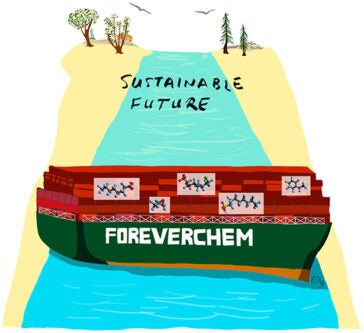 In this award-winning paper, leading PFAS experts collaborated on a set of critical questions to understand and mitigate the impacts of PFAS.
In this award-winning paper, leading PFAS experts collaborated on a set of critical questions to understand and mitigate the impacts of PFAS.
- What are the global production volumes of PFAS, and where are PFAS used?
- Where are the unknown PFAS hotspots in the environment?
- How can we make measuring PFAS globally accessible?
- How can we safely manage PFAS-containing waste?
- How do we understand and describe the health effects of PFAS exposure?
- Who pays the costs of PFAS contamination?
“The importance of each question and barriers to progress are briefly described, and several potential paths forward are proposed. Given the diversity of PFAS and their uses, the extreme persistence of most PFAS, the striking ongoing lack of fundamental information, and the inequity of the health and environmental impacts from PFAS contamination, there is a need for scientific and regulatory communities to work together, with cooperation from PFAS-related industries, to fill in critical data gaps and protect human health and the environment.
The paper was selected as Environmental Science and Technology (ES&T) Second Joint Winner in the Feature/Perspective/Viewpoint category. According to the website, “ES&T has surveyed the landscape of the scientific and technological publications…and has used many criteria, including creativity, rigor, insight, novelty, and many more. Often, one key criterion that distinguishes the many excellent papers that ES&T publishes from those that are selected as being in the category of “Best” is relevance. Relevance to particular emerging pollutants, contaminants, policies, regions, or concerns of the day can be one important factor in making this determination.”
The paper was selected as Environmental Science and Technology (ES&T) Second Joint Winner in the Feature/Perspective/Viewpoint category. According to the website, “ES&T has surveyed the landscape of the scientific and technological publications…and has used many criteria, including creativity, rigor, insight, novelty, and many more. Often, one key criterion that distinguishes the many excellent papers that ES&T publishes from those that are selected as being in the category of “Best” is relevance. Relevance to particular emerging pollutants, contaminants, policies, regions, or concerns of the day can be one important factor in making this determination.”
Ng, C., Cousins, I., DeWitt, J., Glüge, J., Goldenman, G., Herzke, D., Lohmann, R., Miller, M., Patton, S., Scheringer, M., Trier, X., and Z. Wang. Addressing Urgent Questions for PFAS in the 21st Century. Environ. Sci. Technol. 2021, 55 (19), pp 12755-12765. [https://pubs.acs.org/doi/10.1021/acs.est.1c03386]

